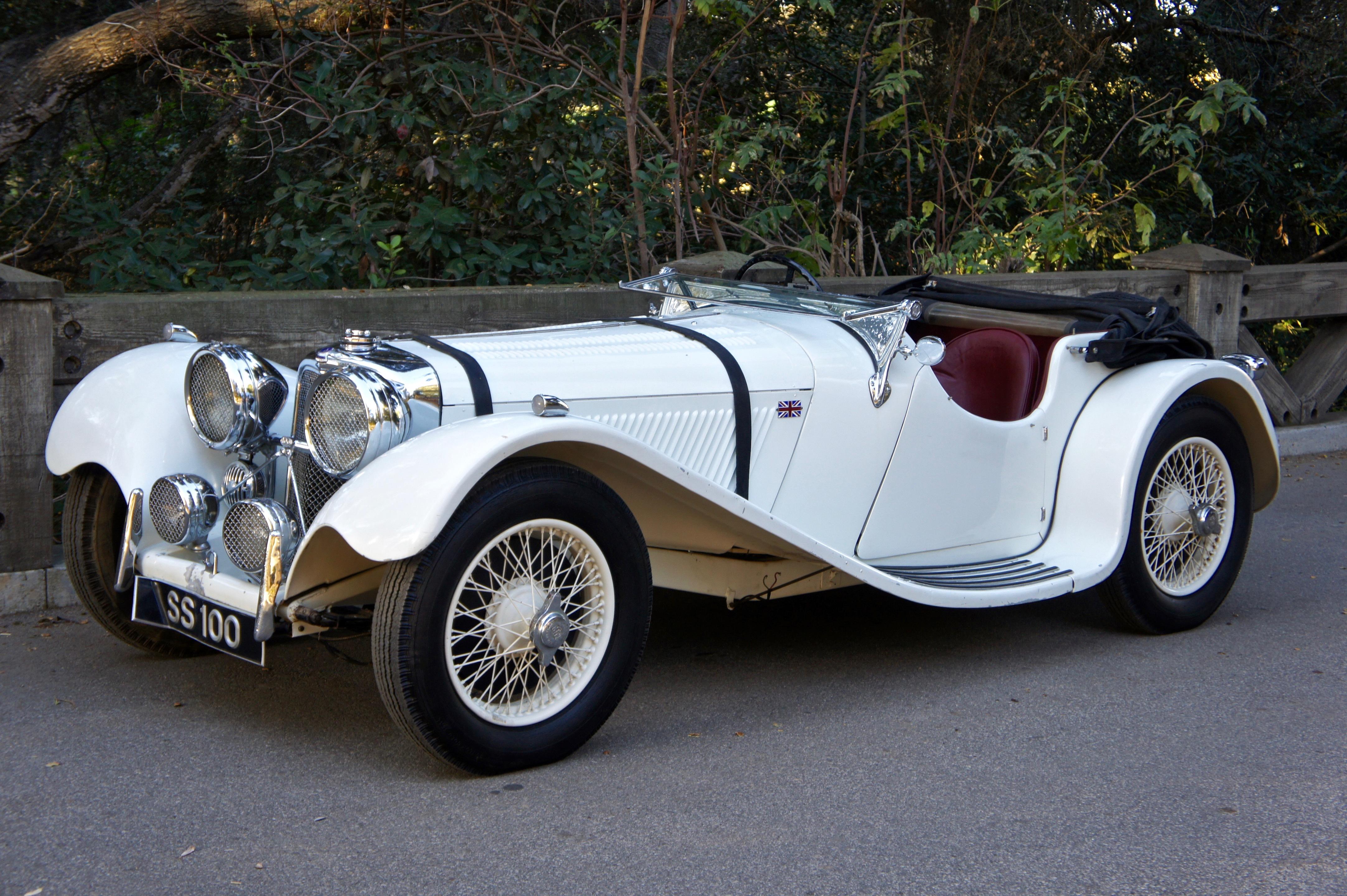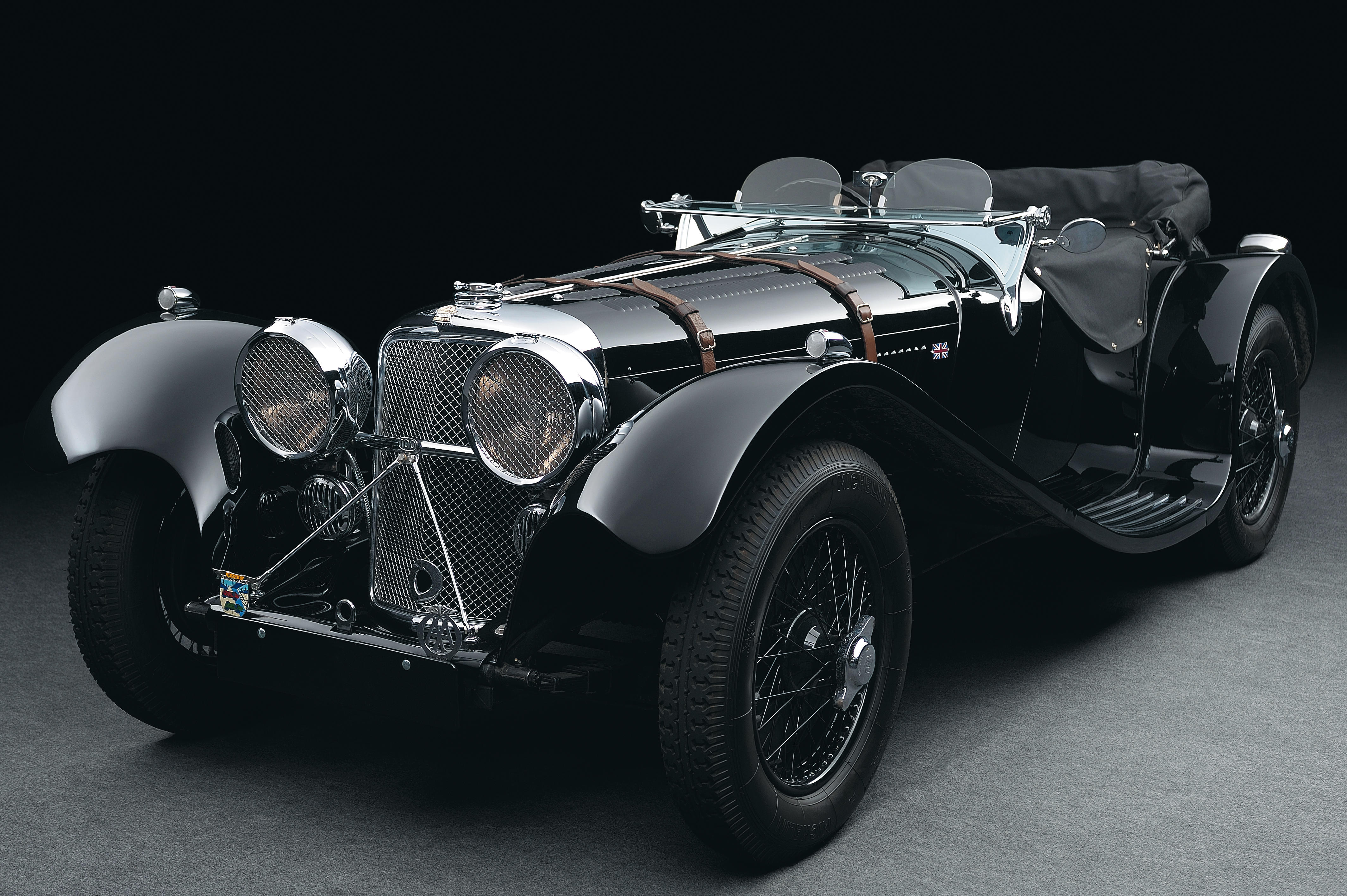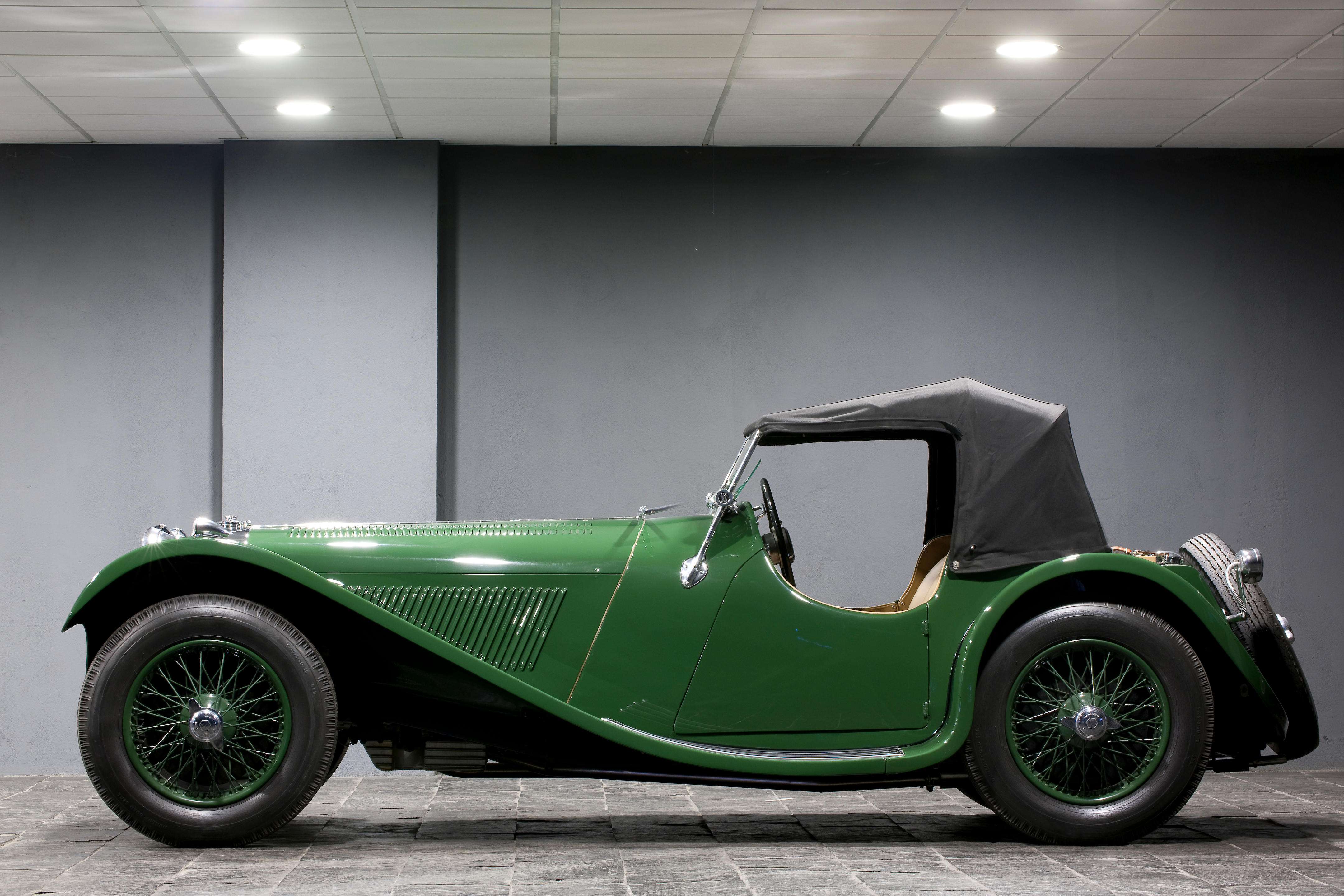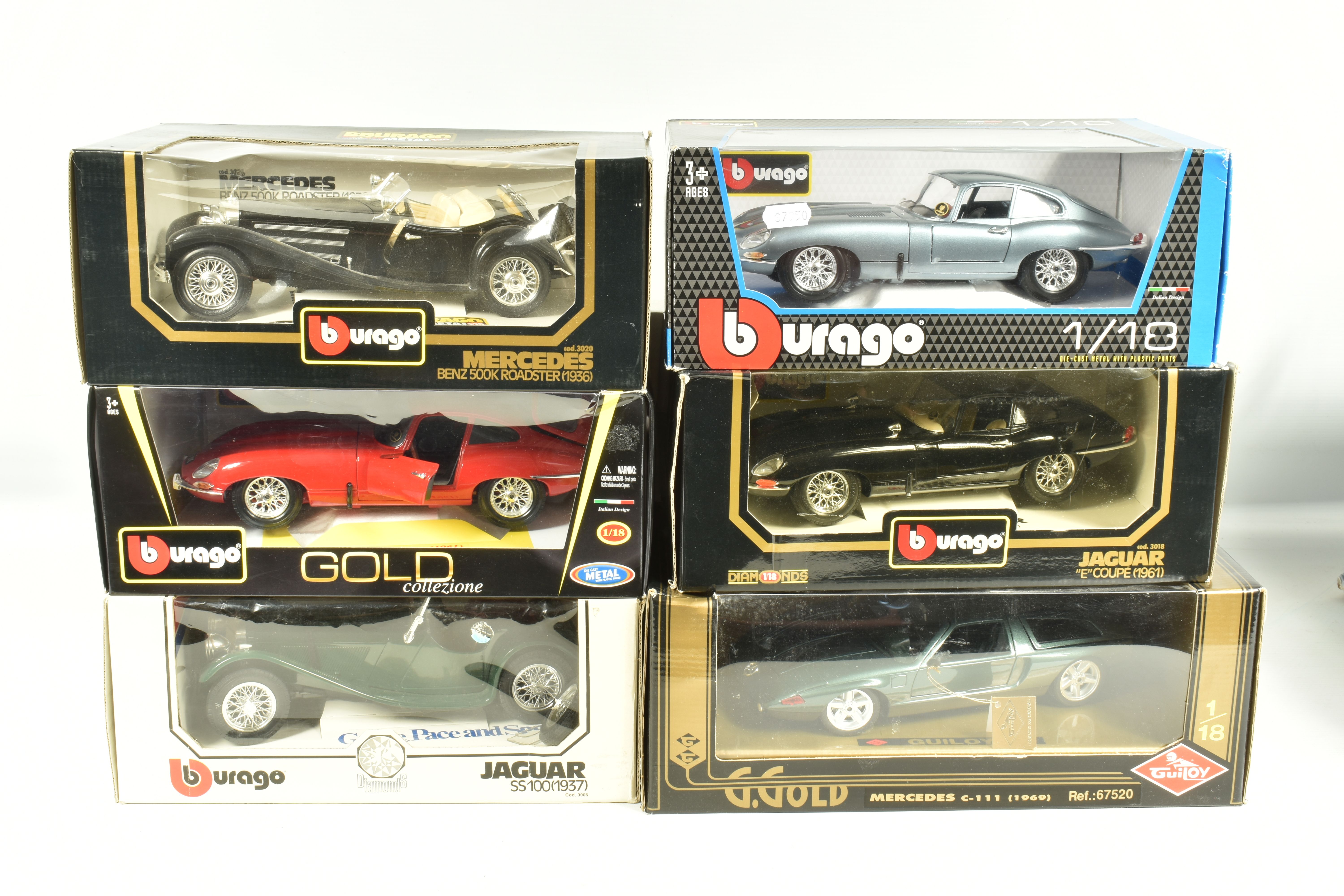Colour: Black Cylinders: 6; 2,663cc Gears: 4 + reverse Power: 104bhp Produced: 1936-1939 Production: 198 (2½-Litre model) Launched for 1936, the SS100 was the first real high-performance model produced by SS Cars Limited and used a new Weslake-developed overhead-valve engine in a shortened SS1 chassis. The introduction of the ohv unit was considered to justify the adoption of a new name for the series, SS Cars boss William Lyons later recalling ‘I immediately pounced on Jaguar as it had an exciting sound to me.’ (‘Jaguar’ would be adopted as the marque name in 1943, ‘SS’ having by then acquired a somewhat tarnished reputation.) ‘SS’ originally stood for the Swallow Sidecar & Coachbuilding Company, which had been founded in Blackpool, England by William Walmsley. The company branched out into motor manufacture in 1926, its first major success being an attractive sports saloon on the Austin Seven chassis, the design being the work of Walmsley’s partner, one William Lyons. Relocation to Coventry followed and the Swallow range expanded to include models on Morris Cowley, Wolseley Hornet and Standard Sixteen chassis. Marque status arrived in October 1931 with the launch of the SS1, the chassis of which was supplied exclusively to Swallow by Standard, who also provided the six-cylinder sidevalve engine and four-speed gearbox. Although unspectacular in performance, the SS1 went some way towards establishing the pattern for future Jaguars, combining sporting good looks with a better-than-average specification and all at a bargain price. By the time the SS90 sports car arrived in 1935, William Heynes had joined as Chief Engineer. Based on a shortened SS1 chassis, re-engineered by Heynes, the SS90 again demonstrated Lyons’ consummate skill as a stylist, its long bonnet, smoothly flowing wings, cut-away doors and truncated tail making it every inch the epitome of the 1930s sports car. Although good for 90mph, the SS90 was handicapped by the limitations of its sidevalve engine, a deficiency that would soon be rectified by another of Lyons’ new recruits, gas-flow consultant Harry Weslake. Launched in 1936 alongside the 2½-Litre saloon, the SS100 Jaguar sports car marked the company’s first use of the ‘Jaguar’ name. Beautifully styled in the manner of its SS90 predecessor, the newcomer employed a shorter, 102”-wheelbase chassis and a revised version of the 2,663cc Standard six which, equipped with Weslake’s overhead-valve cylinder head and breathing through twin SU carburettors, now produced 104bhp. Although a fine touring car, the SS 100 was marketed as primarily for competition work. Its first major success came early, if somewhat unexpectedly, when Tommy Wisdom, crewed by his wife, won the arduous International Alpine Trial in 1936, beating Bugatti and bringing the fledgling marque to the attention of the Continental public. This would be the first of many successful rallying forays, including class wins in the RAC events of 1937 and 1938, and the Alpine (outright) again in 1948. Around 198 2½-Litre and 116 of the later 3½-Litre cars had been made by the time SS 100 production was prematurely ended by the outbreak of war. Chassis number ‘18076’ was first registered ‘BWX 32’ (a Yorkshire West Riding mark) on 25th March 1937 to the Jaguar distributor, Glovers of Ripon. Finished in Grey Metallic with Special Silver interior, it was purchased by one Cecil Maddison, of Middlesbrough on 12th April 1937. Ownership was transferred on 9th June 1939 to Guy Alfreds & Co, of Tottenham Court Road, London, who subsequently sold the car Mrs May Vince, of Whetstone sometime during the same year. After 15 years of the Vinces’ ownership, ‘BWX 32’ was transferred to Richard Zimbler, a known collector, residing in Hockliffe near to Leighton Buzzard in Buckinghamshire. In November 1956 ownership passed to Gordon Thomas Tripp, of RAF Cranwell and Sanderstead, Surrey and thence to Chiltern Cars, back in Leighton Buzzard. Advertised in the May 1958 edition of M
Colour: Black Cylinders: 6; 2,663cc Gears: 4 + reverse Power: 104bhp Produced: 1936-1939 Production: 198 (2½-Litre model) Launched for 1936, the SS100 was the first real high-performance model produced by SS Cars Limited and used a new Weslake-developed overhead-valve engine in a shortened SS1 chassis. The introduction of the ohv unit was considered to justify the adoption of a new name for the series, SS Cars boss William Lyons later recalling ‘I immediately pounced on Jaguar as it had an exciting sound to me.’ (‘Jaguar’ would be adopted as the marque name in 1943, ‘SS’ having by then acquired a somewhat tarnished reputation.) ‘SS’ originally stood for the Swallow Sidecar & Coachbuilding Company, which had been founded in Blackpool, England by William Walmsley. The company branched out into motor manufacture in 1926, its first major success being an attractive sports saloon on the Austin Seven chassis, the design being the work of Walmsley’s partner, one William Lyons. Relocation to Coventry followed and the Swallow range expanded to include models on Morris Cowley, Wolseley Hornet and Standard Sixteen chassis. Marque status arrived in October 1931 with the launch of the SS1, the chassis of which was supplied exclusively to Swallow by Standard, who also provided the six-cylinder sidevalve engine and four-speed gearbox. Although unspectacular in performance, the SS1 went some way towards establishing the pattern for future Jaguars, combining sporting good looks with a better-than-average specification and all at a bargain price. By the time the SS90 sports car arrived in 1935, William Heynes had joined as Chief Engineer. Based on a shortened SS1 chassis, re-engineered by Heynes, the SS90 again demonstrated Lyons’ consummate skill as a stylist, its long bonnet, smoothly flowing wings, cut-away doors and truncated tail making it every inch the epitome of the 1930s sports car. Although good for 90mph, the SS90 was handicapped by the limitations of its sidevalve engine, a deficiency that would soon be rectified by another of Lyons’ new recruits, gas-flow consultant Harry Weslake. Launched in 1936 alongside the 2½-Litre saloon, the SS100 Jaguar sports car marked the company’s first use of the ‘Jaguar’ name. Beautifully styled in the manner of its SS90 predecessor, the newcomer employed a shorter, 102”-wheelbase chassis and a revised version of the 2,663cc Standard six which, equipped with Weslake’s overhead-valve cylinder head and breathing through twin SU carburettors, now produced 104bhp. Although a fine touring car, the SS 100 was marketed as primarily for competition work. Its first major success came early, if somewhat unexpectedly, when Tommy Wisdom, crewed by his wife, won the arduous International Alpine Trial in 1936, beating Bugatti and bringing the fledgling marque to the attention of the Continental public. This would be the first of many successful rallying forays, including class wins in the RAC events of 1937 and 1938, and the Alpine (outright) again in 1948. Around 198 2½-Litre and 116 of the later 3½-Litre cars had been made by the time SS 100 production was prematurely ended by the outbreak of war. Chassis number ‘18076’ was first registered ‘BWX 32’ (a Yorkshire West Riding mark) on 25th March 1937 to the Jaguar distributor, Glovers of Ripon. Finished in Grey Metallic with Special Silver interior, it was purchased by one Cecil Maddison, of Middlesbrough on 12th April 1937. Ownership was transferred on 9th June 1939 to Guy Alfreds & Co, of Tottenham Court Road, London, who subsequently sold the car Mrs May Vince, of Whetstone sometime during the same year. After 15 years of the Vinces’ ownership, ‘BWX 32’ was transferred to Richard Zimbler, a known collector, residing in Hockliffe near to Leighton Buzzard in Buckinghamshire. In November 1956 ownership passed to Gordon Thomas Tripp, of RAF Cranwell and Sanderstead, Surrey and thence to Chiltern Cars, back in Leighton Buzzard. Advertised in the May 1958 edition of M















Testen Sie LotSearch und seine Premium-Features 7 Tage - ohne Kosten!
Lassen Sie sich automatisch über neue Objekte in kommenden Auktionen benachrichtigen.
Suchauftrag anlegen